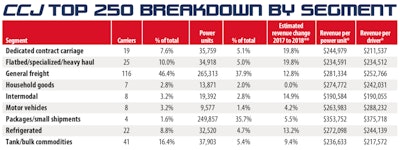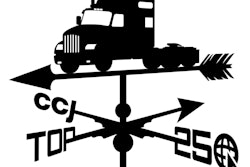
A full, downloadable list of the 2019 CCJ Top 250 is available at CCJtop250.com. There you can also find listings broken down by revenues or number of trucks, tractors, trailers or drivers, and by type of haul and geographic region.
While carriers in the 2019 CCJ Top 250 ranking turned in significant revenue gains across most industry segments, those same companies added little capacity to the system. Year-over-year revenue growth of the carriers that disclosed revenue for the last two years was 9.9%. Excluding package giants UPS and FedEx, that same group turned in a 13.0% increase in revenues.
In a year that saw five of the nine industry segments post double-digit revenue increases, dedicated contract carriage and flatbed/specialized/heavy-haul carriers led the way at 19.8% each, followed by intermodal (14.9%), refrigerated (13.2%) and general freight (12.8%) carriers. Only the household goods segment failed to gain ground in fiscal year 2018.
Notable standouts include Ruan (CCJ Top 250, No. 32), whose 35.9% revenue increase buoyed the dedicated contract carriage group’s numbers; Penske Logistics (No. 20), which posted a 35.3% revenue increase after fully absorbing Epes Transport System; and Evans Network of Companies (No. 25), which posted revenue gains of 28.4% on the heels of its acquisitions of Greatwide Truckload Management and Packard Transport. Other high-achieving fleets include Landstar System (No. 8, 26.6%), Covenant Transportation Group (No. 35, 25.6%), RoadOne Intermodalogistics (No. 68, 33.3%) and Cypress Truck Lines (No. 175, 36.6%).
Trucking bankruptcies were few and far between in 2018, but two carriers are conspicuously absent from this year’s rankings after closing this year. Following two years of losses, New England Motor Freight (formerly No. 67) shut its doors in February, citing rising overhead costs and the driver shortage. NEMF soon was joined by Falcon Transport (formerly No. 146). The 719-tractor fleet lost a major customer and abruptly ceased operations in April, stranding drivers and trailer loads at truck stops across the country. Both carriers were heavily unionized.
No room to expand
Despite solid revenue performance up and down this year’s CCJ Top 250 ranking, the total number of trucks and tractors increased only 3.0% from 679,822 to 699,110. (UPS and FedEx combined account for nearly half of the increase with 9,158 additional power units.) The 238 carriers that appear in both this year’s and last year’s rankings only grew their tractor count at a 2.5% clip, from 480,384 to 492,381 units, and their overall power unit count grew just 3.3%.
CCJ Top 250 equipment counts reflect fleet size at the time of data collection conducted annually in late June and early July. Due to extensive order backlogs across all major OEMs and the lag time between order and placing power units into service during the last reporting cycle, the equipment counts in the 2019 CCJ Top 250 ranking may not yet reflect much of the unprecedented stretch of Class 8 activity from July through October 2018 that saw OEMs rake in orders for 189,605 units, as reported by FTR Transportation Intelligence.
 * Excludes outlying operations that likely would skew a segment’s figures for various reasons, such as an unusual scope or operating profile or the inclusion of revenues beyond North America or transportation by truck. **Based on companies that self-reported revenue data for both 2017 and 2018.
* Excludes outlying operations that likely would skew a segment’s figures for various reasons, such as an unusual scope or operating profile or the inclusion of revenues beyond North America or transportation by truck. **Based on companies that self-reported revenue data for both 2017 and 2018.The driver shortage undoubtedly hindered carrier expansion in the last year, as 2019 CCJ Top 250 carriers account for a total of 810,762 drivers. Unlike last year’s ranking that saw driver growth eclipse power unit growth by a three-to-one margin, a closer look at this year’s metrics reveals driver growth is largely in line with power unit increases across the board. Carriers appearing in the rankings for both 2018 and 2019 added 24,384 drivers, a 3.1% increase from 781,438 to 805,822.
As a group, dedicated contract carriage carriers appearing in both this year’s and last year’s CCJ Top 250 rankings led all other industry segments in percentage growth for both power units and drivers. The segment increased its power unit count by 11.4% and driver count by a whopping 17.4%, thanks in large part to Ryder reporting 3,158 more drivers in its integrated logistics division. Even without Ryder’s growth, driver ranks among dedicated contract carriage companies grew 9.2%.
The second-best performing group was intermodal carriers, which turned in a power unit increase of 6.7% and a driver increase of 8.3%. The flatbed/heavy-haul/specialized carrier group also grew its equipment counts by 6.7%, while carriers in the refrigerated segment that appeared in both the 2018 and 2019 CCJ Top 250 rankings grew their driver base by 8.3%.
The household goods segment was the only category that shrunk its power unit counts year-over-year, losing 1,241 pieces of equipment for an 8.2% decrease. The motor vehicles group turned in the lowest driver growth of any segment, with seven carriers that appear in both this year’s and last year’s rankings totaling a 0.7% increase.
Getting together
While this year lacks the blockbuster merger the industry saw when Knight Transportation and Swift Transportation joined forces, there were several notable mergers and acquisitions that helped change trucking’s landscape.
In the motor vehicles segment, United Road Services (No. 55) purchased Fleet Car Carriers (formerly No. 143) and its 620 leased tractors and drivers. The move solidifies United Road’s hold on the No. 1 spot in the segment group ahead of Jack Cooper Transport, and the Michigan-based hauler expects to transport more than 4.5 million vehicles in 2019.
Indianapolis-based Wheaton Van Lines (No. 71) jumps 30 spots in the CCJ Top 250 ranking with the acquisition of fellow household goods hauler Stevens Worldwide Van Lines (formerly No. 203).
The tank/bulk commodities segment saw two major acquisitions in 2018. Enid, Okla.-based Groendyke Transport (No. 101) purchased the tank truck assets of McKenzie Tank Lines in a move that grows Groendyke’s terminal count from 30 to 40 and adds an expected $40 million in revenue this year. Heniff Transportation Systems (No. 104) makes its CCJ Top 250 debut after acquiring Miller Transporters (formerly No. 196), creating a new player in tank/bulk commodities.
Wilson Logistics (No. 109) continues its recent string of acquisitions with the addition of Market Transport (formerly No. 233), a Portland, Ore.-based asset-light carrier with roughly 400 tractors and drivers. The move expands Wilson Logistics’ lane density in the Northwest and brings the Springfield, Mo.-based carrier’s equipment count well past 1,000 power units.
Refrigerated hauler J&R Schugel (No. 119) acquired Super Service (formerly No. 142) in mid-2018. The Grand Rapids, Mich.-based dry van fleet adds nearly 700 tractors and drivers to J&R Schugel’s operations and sends the New Ulm, Minn.-based and employee-owned company rocketing up this year’s list.
Canadian carrier Day & Ross Transportation Group (No. 143) purchased the A&S Kinard and Buckler Transport subsidiaries of Celadon Trucking Services (No. 41) as the company continues to shed non-core business units. The acquisition provides Day & Ross with dedicated and specialized services in the Northeast and Mid-Atlantic regions and moves the carrier up 23 spots overall and seven spots in the general freight segment rankings.













